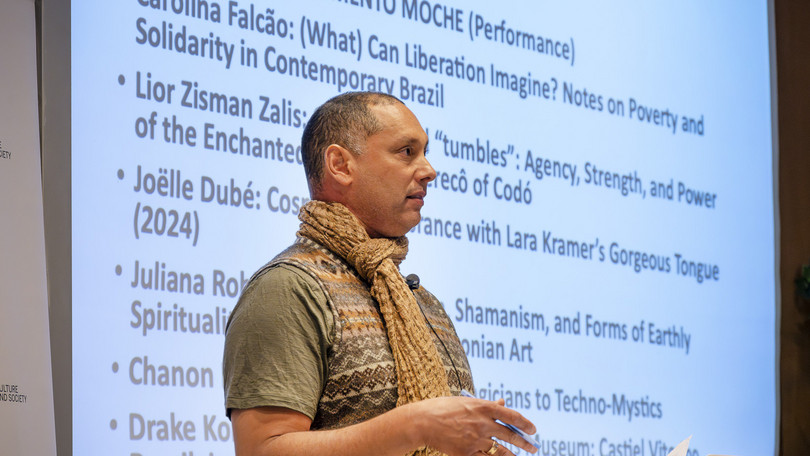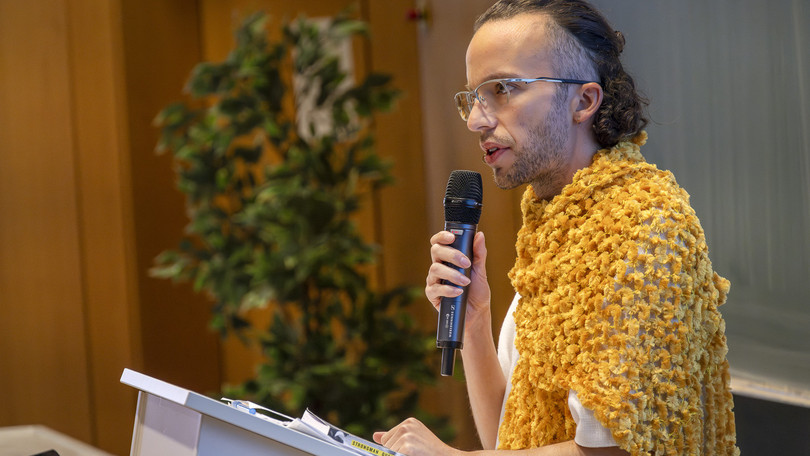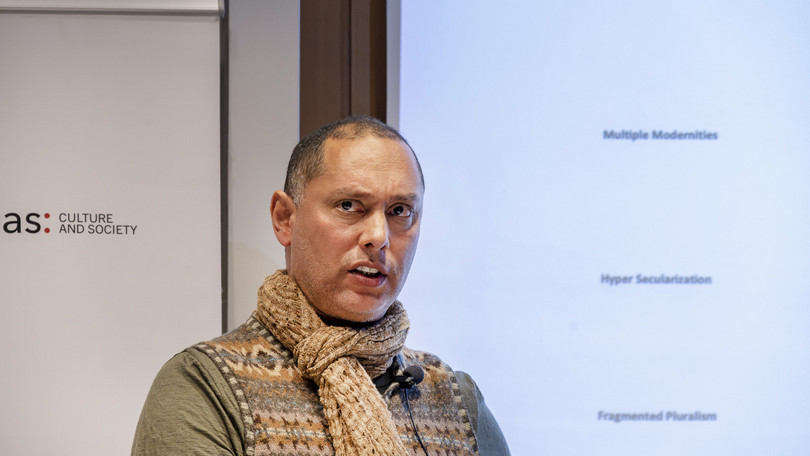“We are here” - Research as a Pilgrimage
LIAS Lecture – Roberto Strongman: Postsecular Pilgrimages, Imaginary Sources, Disappointed Returns
2025-05-19
The lecture, delivered by Roberto Strongman on May 14, was part of the Masters Seminar “Post-secular Critique” led by Sebastián Eduardo Dávila. Organised under the umbrella of Leuphana Institute for Advanced Studies (LIAS) in Culture and Society, the event included workshops and panels exploring critical intersections of the secular, religious, and post-secular. The planned performance Momento Moche—centred around pre-Columbian ritual aesthetics and nonlinear temporalities—was cancelled due to a personal tragedy. The organisers honoured this loss through a moment of candle-lit silence, reinforcing the theme of absence and reverence that would echo throughout the lecture.
Key terms were framed early on: The term “postsecular” not only as a historical diagnosis but as a promise; “reckoning” as a way of addressing complex entanglements of past, present, and future in Latin America’s often violent histories. This framework guided the introduction of Roberto Strongman, whose book Queering Black Atlantic Religions (2019) presents an interdisciplinary, transpossessional approach to spirituality and gender.
Roberto Strongman began his lecture by interrogating the genre of the keynote itself—as a framing device for discourse—and reimagined it as a sacred pilgrimage, inviting both spatial and temporal reflection. He used the metaphor of pilgrimage to unify the themes and participants of the conference, referencing the “Canterbury Tales” as a model: a collective journey where each speaker contributes their own narrative towards a shared spiritual destination.
The lecture was woven through with both personal and anthropological journeys. Strongman shared his upbringing in Panama, displacement, and eventual return through scholarly work. Pilgrimage, in his framework, is both literal and symbolic—a journey of return, remembrance, and spiritual reckoning. He discussed the Black Nazarene (Nazareno) of Panama as a diasporic religious figure that decentralises national and religious history. Merchant stalls and everyday devotional spaces become modern altars—material manifestations of creolised spiritual continuity.
Silence held significant theoretical and emotional weight. Citing John Cage’s composition 4’33, Strongman invoked silence as both absence and presence, a medium for addressing loss and meditative attunement. The audience was invited to share three breaths in silence, acknowledging both the cancellation of Momento Moche and the deeper themes of rupture and continuity.
Strongman’s theoretical framing drew on anthropological classics—Victor Turner’s concept of liminality in The Ritual Process: Structure and Anti-Structure (1969), Mircea Eliade’s sacred/profane dichotomy (The Sacred and the Profane, 1957), Van Gennep’s Rites of Passage (1909), and Joseph Campbell’s monomyth in The Hero with a Thousand Faces (1949). These thinkers collectively shaped the understanding of pilgrimage as a transformational, boundary-crossing process. Strongman synthesised these models into a broader temporal and historical overview of how religion, secularity, and post-secularity have evolved.
The historical trajectory of religion and secularity traces a complex evolution, Strongman explained. In antiquity, religion was inseparable from life. The Christian Empire fused spiritual and political power, while medieval Christendom upheld a sacred order with marginal secularism. The early modern era saw the rise of the secular state post- Westphalia. The Renaissance and Reformation fractured religious authority, shifting faith inward. Enlightenment thinkers privileged reason, leading to a science-dominated world-view. The 19th and 20th centuries deepened the religion–reason divide, culminating in crises of belief after two world wars. Since the 1990s, we witness a post-secular age, marked by religion’s political and cultural resurgence.
Visual material such as Bill Viola’s The Crossing (1996) illustrated the post-secular’s aesthetic—stillness, mystery, and elemental symbolism. These visual moments paralleled the affective dimensions of Momento Moche, emphasising the power of ritual and the sacred in contemporary art.
The lecture concluded with critical reflections on methodology, terminology, and the geopolitical relevance of the post-secular. Questions from the audience challenged Eurocentric narratives and interrogated the application of secular frameworks to Latin American and African contexts. Strongman acknowledged that concepts like “Third World” or “Global South” are linguistically flawed but provisionally useful. He highlighted how in many African societies, the spiritual and political remain indivisible—raising the need to rethink secularism outside of Western paradigms.
Autobiography was framed as both method and epistemology. For Strongman, knowledge emerges from lived experience and embodied participation; the researcher is also the pilgrim. Ultimately, Strongman urged the audience not to seek final destinations but to be present in the journey. The post-secular, he suggested, is not a linear endpoint but a condition of layered transitions—between histories, identities, and cosmologies. As we face forks in the road—between transhumanism, re-sacralisation, and ecological spirituality—the most urgent task is to ask, “Where are we?” And to answer: “We are here. Let us be here.”



